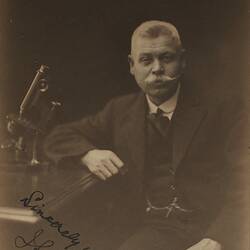Summary
Electric impulse clock, made by James Searle, Melbourne, 1931. Commissioned by Melbourne clock collector John Askew to demonstrate the use of the Hipp principle in timekeeping.
Mathias Hipp of Germany designed an electrical impulse clock in the 1830s in which the pendulum received an electro-mechanical impulse only when its swing had decreased sufficiently to trigger an electromagnet. The pendulum drove a ratchet wheel which in turn drove the clock train. Clocks designed to the Hipp principle continued to be used as master clocks into the 20th century.
Physical Description
Clock mechanism is suspended on a polished backboard. Electric impulse movement.
More Information
-
Collecting Areas
-
Acquisition Information
Loan & Subsequent Bequest from Mr John Askew, 03 Sep 1931
-
Maker
James Searle, 4 Queens Walk, Melbourne, Greater Melbourne, Victoria, Australia, 1931
-
Commissioned By
Mr John Askew, Melbourne, Greater Melbourne, Victoria, Australia, 1931
-
Classification
-
Category
-
Discipline
-
Type of item
-
Overall Dimensions
137 cm (Length), 23 cm (Width)
-
Keywords



